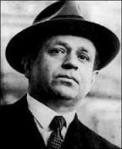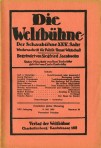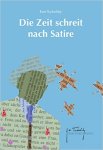The first ruins appear along the railway lines – starting roughly at Vitry. Ruins, buildings without roofs, plaster hanging down, beams sticking up in the air. Only a small section – then the area becomes orderly and repectable, clean and nicely-built again. A lot of the houses seem to be new. The train stops. A carriage in a siding has the word ›FUMEURS‹ written on a door. The first two letters are hidden by a post, only the rest of the word is legible.
Verdun, a small, provincial town. It had already been a victim once in modern times, in 1870. The defending garrison surrendered with all military honours and withdrew, and the town fell under German administration. The German official responsible for it and the Departement of the Meuse, bore the name von Bethmann Hollweg[1].
There is a little book for sale: ›Verdun before and after‹. It must have been a pretty, neat and friendly town, with little cottages by the river, a cathedral, and the rise and fall of the country roads in the rolling landscape. Every historical photo is followed by another. It no longer looks that bad: a lot has been restored, some parts were not even damaged, the town hall was almost untouched. But it is not just about Verdun, not just the little town. Verdun was surrounded by thirty-four forts.
Right at the exit of the town is the Citadelle. It is dug into the rocks, a huge construction, with a total length of sixteen kilometres of tunnels. You can still visit some of it. The sleeping quarters of officers and men, with heating and electric light. General Pétain slept here, in this alcove. A little room, with wooden walls, open at the top – washing bowl, bucket and bed are still there. Then come small cubicles for four officers each. In a larger room stands a long table on which coffins containing the remains of eight unidentified bodies stood. An officer laid a wreath on one of them, who became the unknown soldier who is now buried under the Arc de Triomphe in Paris. The other seven rest in a common grave in the churchyard Faubourg Pavé near Verdun. The bombardment was not able to destroy the rock citadelle – it dislodged some external masonry, everything inside remained intact. And then we go outside, into the open.
It is a wide, hilly area, with a lot of shrubbery and no woods. From any raised ground, you can see for a long way. A million men died here.
Here is where they showed each other who was in the right in a dispute whose aims and purpose nobody any longer knew after a few months. Here the customers of Krupp and Schneider-Creusot supported their domestic industry. (And it is not yet even clear who supplied whom.)
Four hundred thousand men fell on the French side, of whom nearly three hundred thousand are missing, submerged, disappeared… The area looks like a grassed-over lunar landscape, the fields are almost uncultivated, there are holes and depressions everywhere, where shells landed. Twisted iron on the roads, smashed-up trenches, holes in which human beings once lived. Human beings? They hardly were any more.
Over there, near Fleury, there is a cemetery, in truth a mass grave for ten thousand. Ten thousand times a life destroyed, a hope wiped out, a small group of people made unhappy. Here was no-man’s land: over there on the raised ground lay the Germans, over there the French – here was unoccupied. Larks have risen up into the air and are singing an endless whirl of sound. A thin rain falls.
The vehicle stops. This small group of hills is Fort Vaux. A French soldier leads, with a carbide lamp in his hand. Someone is smoking a pungent tobacco, and you can feel the atmosphere of soldiers, which is the same all over the world: the smell of leather, sweat and hay, food, tobacco and human transpiration. It goes down a few steps.
Here. Two nations fought each other for four years for this coal-cellar. That was where everything stopped. Whether in the one direction or the other. Everything stopped here. Stone galleries, lined with concrete, the walls are damp and dripping. In this wooden passage lay the Germans. Opposite, one meter away, the French. Here they murdered, man against man, hand-grenade against hand-grenade. In the dark, day and night. There is the telephone booth, There is a small room in which negotiations for a handover took place. On 8th June 1916, the fort fell. Fell? The soldiers had to be hacked out in groups, with bayonets, flame throwers, hand-grenades and with gas. They had no water for the last two days. There is still a German inscription on a wall, painted in black, difficult to decipher. And then we go into the first-aid room.
It is a narrow hole, there was probably room for three tables. One is till there. Small cupboards hang on the walls. Above, reachable via some steps, is the doctor’s alcove. I once visited the old synagogue in Prague, half underground, into which the Jews used to crawl when the stones were flying outside. The walls have absorbed the prayers, the room is full of heartache. This here is much more terrible. The screams stick to the walls. Everything that was damaged above was patched and bandaged, gasped, suffocated, screamed and died here. And the helpers? What double heroism to work in this hell! What could they do? To unwrap out of bloody rags the life that they still contained, smear some ointments and tinctures on the burned and crushed flesh of the comrades, and cut and gouge and amputate…
Comfort? They didn’t even know whether they would get these stumps out alive! Sometimes everything was cut away. The water-carrier, the messenger, surely one of the most terrible duties of the war, this is where the true heroes were, not in the staff quarters! The water-carrier, who sacrificed himself with the jerry-can in the hand, rarely came back. And the next one stepped forward… We look around the empty room which is scoured until it shines. Nobody says anything. There are a few red-brown stains above, on the tin shade of the electric lamp. Probably rust…
Graves have been erected in front of the door for some of the fallen. These are rare exceptions, they are on their own, and they are identified. On one of them hangs a small tin wreath with silver letters: Mon mari.
And on a slope there are old guns, the flat, obliquely cut French water bottles, rusty, dented and full of holes. That was once held to thirsty lips. Water flowed into an organism so that it could keep on murdering. Again, again!
Over there is Fort Douaumont, which fell surprisingly; there is Hill 304; there the Fort de Tavannes. Redolent names, aren’t they? An old soldier who was in action here and got out with his life, must feel strange when he sees this place again, quiet, impassive, no shooting. Over on the horizon is the smoke of that which German idealism so badly missed in 1914: the ore deposits of Briey. And we drive on.
The forward lines have sunk into the earth, the poor lads who were sent forward here when they were no longer required as munitions workers behind the lines. They work much better and more effectively for the factory owners here at the front. The munitions industry was father and mother to them; school, books, the newspaper, the three times accursed newspaper, the church with the Lord God decorated in the national colours – all that belonged to the captains of industry, distributed and controlled like the shareholdings. The state, the poor cow, was allowed to sing the national anthem and declare war. It was prepared, brought about, fought and ended elsewhere.
And the parents? Did they have sons, make their beds, teach them to read, following the text with the index finger, name them as heirs, for this? You would expect them to say, “Revenge, because you took from us the only thing we had, our son!” But they gave up the son, the sons, without much thought. They pay taxes much less willingly. The most unnatural thing in the world is a mother who is proud to see the fruit of her womb sink in mud and shit. The photograph and medals framed behind glass, »My Arthur!« And what if it starts again tomorrow?
The guide gives names and statistics. He indicates a long way across the countryside: there, at the back, there at the very back, was the headquarters of the Crown-Prince. A bit far from the action, but I know: that’s in the nature of the business. And it was always that way: the sons were always in charge of home defence. Trees poke their wooden stumps in the air, one can hear Karl Kraus’ poem, »I used to be a forest. I used to be a forest.« The shrubbery thrives, everywhere laced with barbed wire. At one point there is a memorial, a dead lion. That was the furthest point which the Germans reached. (Incidentally, the enemy is not insulted in the slightest, anywhere. Always and everywhere, in the explanations, descriptions and labels, the enemy is respected as a fighting soldier, and never described otherwise.) So, this is how far they got. Germany reached from Berlin to here at that time. Farewell kisses at the station, the journey, 8 horses or 40 men per carriage, and then death in these fields. That was the last extremity.
And behind it the country. There lay this monstrous army encampment, this vanity fair, this concentration of brutality, monotony, official crimes, and wrongly understood heroism. Watchmakers, telegraphists, trade unionists, teachers and bank clerks disguised as soldiers drove, marched, rolled, telephoned, worked and shot, led and leading, deceived and deceiving, murdering without seeing the enemy, killing collectively, always passing on the responsibility to the next. It was a battle factory, the mechanization of battle, impersonal, transpersonal. ›The Division‹ was committed, thrown in, the throwers remained outside, withdrawn. Achilles and Hector fought each other; this war was bought ready-made. And the terminology with which one lied about it was just archaic: the glistening sword, fluttering flags, crossed blades. Mercenaries? Factory workers of death.
The horizon is grey, it is as if there were no longer life in the area.
They fought here, breast to breast: proletarian against proletarian, class camerade against class camerade, tradesman against tradesman. Uniformly constructed economic strata tore each other apart, the people attacked itself, but only one, the workers. Others rubbed their hands in fear in the rear.
A wall appears, the memorial over the Tranchée des Baïonettes. On the 11th June 1916, the soldiers in this trench, it was the second line, were buried alive. Nobody escaped. They were found like that, underground, only the bayonets stuck up out of the ground. The trench has been preserved like that since then. An American, Georges F. Rand, built a big, grey stone building over it. Underneath, on top of the submerged trench, there are a few crosses and wreaths, and the bayonets stick out. Three men must have been posted outside the trench; the barrels of their rifles stick a few centimetres out of the ground, one trips over them. A mother can bring her child here and say, »See? That’s daddy down there.«
Nearby is an ossuaire, a little wooden hall in which the bones of the soldiers who could no longer be identified were collected. They are lying there until a big funerary chapel has been built for them. The remains are arranged by sector. (As far as the officers of all countries are concerned, they all seem to have died of contagious illnesses. Why else would they so often have been separated from the men?) Stereoscopes are set up, with pictures from the murderous days. In one of them you can see a leg under rubble. A torn off leg, to judge by the bindings a German one.
Another one shows a German prisoner, a bearded, undernourished man. He is standing up to his hips in the trench, he has no belt on, he is waiting to see what is going to happen to him. In the foreground, a pair of boots and half a body are sticking out of the mud. He can no longer be taken prisoner. The French and the German are standing next to each other, the observer must think he is looking at a bunch of madmen, which he probably is.
Now it is raining in a heavy stream. The vehicle rolls. The mud splashes. And everywhere barbed wire, rubble, rusty corrugated iron.
Is it all over?
Atonement, penance, absolution? Is any newspaper today still crying out, »We were wrong! We were misled!«? That is the least that one could expect. Is there even one which, during the years since the end of the war, has kept showing its readers the true face of war, like they showed them the repulsive enthusiasm for murder for years?» But we didn’t want to be confiscated!« And afterwards? When there was no censorship any more? What couldn’t you do then? Have you once, just one time, at least afterwards, shown the full, naked, lousy, bloody truth? The newspapers want news. Everybody wants news. Nobody wants the truth.
And out of the grey of the sky a huge figure appears to me, a tall, lean officer, with unbelievably long legs wrapped in webbing, a smart figure with a monocle in his eye. He smirks. And crows, with a slightly cracked voice, with a voice which has shouted at half of Germany, in the barracks, and before which the world shivers in horror,
»Again! Again! Again!«
[1] German Chancellor during the First World War.
Published in:
 Tucholsky Works
Tucholsky Works  Tucholsky Reader
Tucholsky Reader  Tucholsky Panter, Tiger & Co.
Tucholsky Panter, Tiger & Co.
 Tucholsky Essays
Tucholsky Essays  Tucholsky Everybody’s Talking
Tucholsky Everybody’s Talking





Reblogged this on Sarvodaya and commented:
A powerful excerpt that observes one of the most horrific and bloody battles in one of histories most horrific and bloody wars. In light of such staggering loss of life, it’s little wonder why so many Europeans were exhausted by the prospect of yet another war just twenty years later.